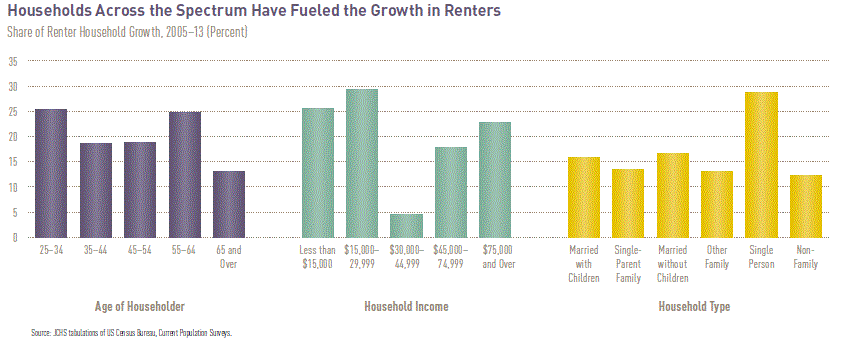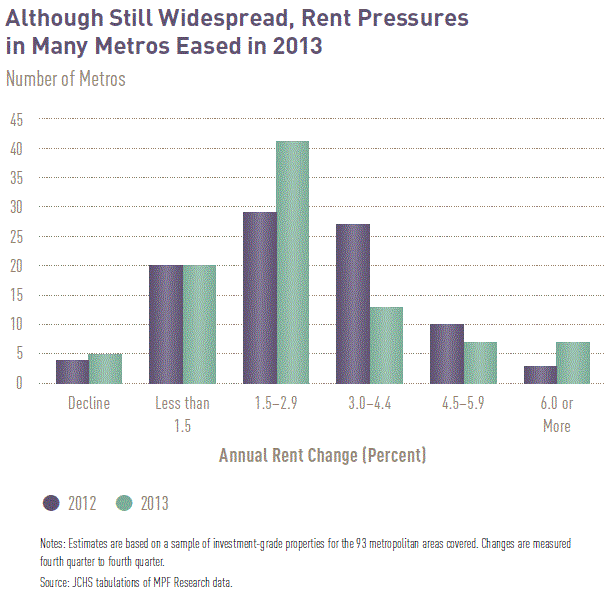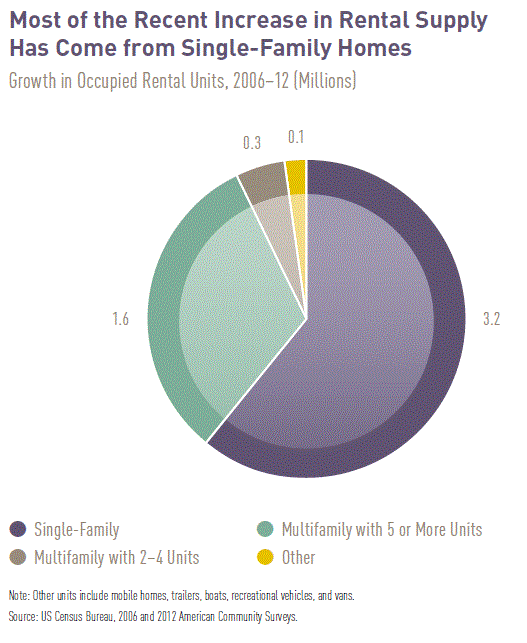Blog

Rental Market Stabilizing but Renter Profile is Changing
While the magnitudernisn’t clear, that the growth of renter households has risen far above average</bin recent years is. The Housing Vacancy Survey reports that the number of thesernhouseholds increased by half a million in 2013 while the Current PopulationrnSurvey reports nearly double that number. rnIn the fifth part of its report on ThernState of the Nation’s Housing, the Harvard Joint Center on Housing Studiesrnsaid either number exceeds the 400,000 annual increase of the last few decades. The report also notes that this increasernappeared to slow at the end of 2013 along with the drop in homeownership rates.rn</p
Along with growth,rnthere has been a shift in the renter population. The usual groups, young adults, low-incomernhouseholds, and singles have been joined by high-income earners, families withrnchildren, and older persons. While those under age 35 account for a quarter ofrnrenter growth, renters 55-64 ballooned almost as much. </p
The recessionrnexpanded the ranks of lower income households and these in turn accounted forrnthe largest share of renter growth. Those earning under $15,000 per yearrnaccounted for a quarter of the growth and those with incomes of $15-29,999 forrn30 percent. Families with children havernhad the sharpest drop in homeownership and the greatest spike in renting whilernthe highest income earners contributed to 23 percent of the growth. </p
 </p
</p
The continuedrngrowth in demand for rentals was not immediately met by supply and the rentalrnvacancy rate tightened to 8.3 percent in 2013, the lowest since 2000. However it represented the smallest shrinkagernin the rate since 2010. The vacancy raternfor professionally managed apartments has not changed in over two years.</p
Rent increases havernbeen relatively constant, about 2.8 percent in both 2012 and 2013 while rentrnhikes in professionally managed buildings have slowed from 3.7 percent to 3.0rnpercent. Both rates outpace the 1.5 percent growth in inflation. The same patterns holds through mostrnmetropolitan areas.</p
 </p
</p
The supply is nowrncatching up with rental demand. rnConstruction starts for multifamily buildings have moved from a low ofrn109,000 units in 2009 to 300,000 in 2013, 13 percent fewer than at the 2005rnpeak and 90 percent of those units are intended as rentals. But these gains may be short-lived; permitsrnincreased in 2013 at half the rate of 2012. rnStill completions should continue to grow from the 195,000 units in 2013rnas much construction may still be in the pipeline. </p
Even at thernrecently increased pace, multifamily production is below the average for thernlast decade in many markets. Permitsrnexceed the 2000s averages in 47 of the largest 100 metro areas but were lessrnthan half those levels in 23.</p
Investment grade properties appear to bernclose to supply/demand balance; the growth in each was about 160,000 units inrn2013. Rent gains in these units has beenrnmore modest and even if demand remains constant the expected growth inrncompletions should create some slack. </p
The growth in new multifamilyrnconstruction, 1.6 million units from 2006 to 2012, met just a fraction of therngrowing rental demand from 5.2 million households. The conversion of owner-occupied singlernfamily homes to rentals provided most of the new supply. An estimated 3.2 units converted to rentalsrnduring this period, pushing the single-family composition of the market from 30rnpercent in 2006 to 34 percent six years later. </p
 </p
</p
Single-family rentals have traditionallyrnbeen owned by individual investors but the high volume of distressed homes forrnsale, weak demand from owner occupants, and high rent-to-price ratios enticedrninstitutional investors to buy following the recession. An estimated 200,000 single family unitsrnwere bought by these investors between 2012 and early 2014. </p
These investments were concentrated inrnselect markets and now with the distressed market shrinking there is evidencernthese investors are pulling back. However the experience they gained in managingrnand financing large portfolios of single family housing may provide newrnbusiness models for investors to follow; several have issued securities backedrnby cash flow from these rentals. Therernare also implications for communities with large concentrations of theserninvestments should their owners opt out of ownership.</p
New construction typically tends towardrnhigher priced units; the median rent for new units in 2010 was $1,052,rnaffordable by traditional measures to those earning over $42,200. Only a third of units built in 2010 rentedrnfor less than $800, “affordable” for a household earning $28,000. Buildingrnaffordable housing is difficult because of the high cost of appropriately zonedrnland and financing for acquisition and development on top of actualrnconstruction costs.</p
Meanwhile at the low end owners may lackrnrevenue for operating and maintenance, putting these properties at risk forrnremoval. Some 1.9 million of the 34.8rnmillion rentals that existed in 2011 (5.6 percent) had been demolished 10 yearsrnlater and the loss rate for units renting under $400 was twice that high,rnaccounting for a third of all removals. rnRemoval rates decline as rents increase to 3.0 percent of units withrnrents over $800.</p
Losses are particularly high in ruralrnareas, 8.1 percent compared with 5.7 percent in central cities and 4.7 percentrnin suburbs, reflecting the greater presence of mobile homes. These homes account for 10 percent of thernhousing stock in the South and West and more than one in five was removedrnbetween 2001 and 2011.</p
The Center said that low vacancies andrnrent increases that consistently outrun inflation means apartment propertiesrncontinue to perform well. Net operatingrnincome of commercial grade properties were up 3.1 percent in 2013, below thern6-11 percent growth in 2011-12 but still nearly matching the three decadernaverage. </p
Apartment values are appreciating atrnwhat the Center calls a remarkable pace, up 14 percent on average in 2012-13 torna new high; beating the 2007 peak by 6 percent, far outstripping owner-occupiedrnmarket recovery. Cash flow and appreciation led to a 10.4 percent annual raternof return on commercial grade properties in 2013, nearly matching the 11.5rnaverage of 1995-2004 and suggesting more sustainable growth.</p
Multifamily loan delinquencies arerntrending down with serious (90+ days) delinquencies slipping below 1.0 percentrnin 2013 for the first time in five years. rnDelinquencies in Fannie Mae and Freddie Mac backed CommercialrnMortgage-backed Securities (CMBS), while still high by historical standards,rnalso dropped under 1.0 percent.</p
Private multifamily lending hasrnrebounded. According to a MortgagernBankers Association survey, these originations were up 36 percent in 2012 and 13rnpercent last year. Of note is thatrnlending by banks and thrifts which was flat in 2010 had jumped 29 billion byrn2013 while government backed loan, the dominant factor in multifamily lending earlyrnin the recovery, increased by only half that amount. </p
The Center projects that, as long asrnthey perform well, multifamily properties should attract increasing levels ofrnprivate funding. In the meantime, plansrnto shrink federal involvement have been put on hold because of rising demandrnand to address affordability challenges.rn</p
The Center points to the difficulty inrnpredicting homeownership rates and thence rentership rates because of theirrndependence on several economic and attitudinal factors. But assuming that homeownership isrnstabilizing and that new rental units continue to come on line, the Centerrnestimates that demographic forces alone will left the number of renterrnhouseholds by 4.0 to 4.7 million over the ten years ending in 2023, exceedingrnlong-ran averages over the past several decades. </p
Two broad trends will drive this; thernimminent surge in older households; renters over age 65 are projected to risernby about 2.2 million or about half of market growth, and the increasingrnracial/ethnic diversity of younger age groups. rnThe aging population also means that the share of renters who are singlernor married without children will soar. rnMeeting this diverse demand will require a range of new rental optionsrnand a variety of community settings.
All Content Copyright © 2003 – 2009 Brown House Media, Inc. All Rights Reserved.nReproduction in any form without permission of MortgageNewsDaily.com is prohibited.
Latest Articles
By John Gittelsohn August 24, 2020, 4:00 AM PDT Some of the largest real estate investors are walking away from Read More...
Late-Stage Delinquencies are SurgingAug 21 2020, 11:59AM Like the report from Black Knight earlier today, the second quarter National Delinquency Survey from the Read More...
Published by the Federal Reserve Bank of San FranciscoIt was recently published by the Federal Reserve Bank of San Francisco, which is about as official as you can Read More...

Comments
Leave a Comment